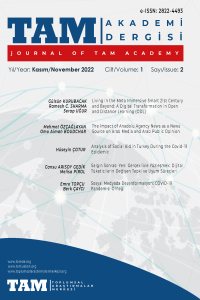Kritik Kitle Teorisi ve Toplumsal Hareketlere Katılım: Türkiye'de Gezi Eylemleri Örneği
27 Mayıs 2013'te Gezi Parkı'nda tarihi parka AVM yapılmasını protesto etmek için düzenlenen miting, gençlerin 1968 Türkiye kuşağına göre apolitik olduğunun iddia edildiği bir dönemde farklı yaş, sınıf ve siyasi görüşten katılımcı sayısının giderek artmasıyla ülke çapında kolektif bir harekete dönüştü. Bu olgu, o dönemlerde sadece uluslararası basın ve haberlerin ilgisini çekmemiş, aynı zamanda akademik çalışmalar için öne çıkan ve tercih edilen bir konu haline gelmiştir. Bu sebeple, Gezi Ayaklanması'nı ve Gezi katılımcılarının profilini, psikolojisini ve motivasyonunu inceleyen çok sayıda yayın bulunmaktadır. Literatür taraması yoluyla toplanan verileri analiz ederken Kritik Kitle teorisini kullanan bu çalışma, 2013 Gezi protestolarının Türk siyasi ve toplumsal tarihinin en büyük toplumsal hareketi olarak nasıl ortaya çıktığını anlamak için farklı motivasyonlara sahip heterojen katılımcı profillerinin kolektif eylemini ve karşılıklı bağımlılığını incelemektedir. Bu çalışma, günümüz Türkiye'sindeki hoşnutsuzluk oranının 2013'ten çok daha yüksek olmasına rağmen, neden büyük çaplı bir gösteri olmadığını tam olarak cevaplamayı amaçlamamaktadır. Ancak Kritik Kitle teorisi, Soğuk Savaş sonrası, ayaklanmalara önderlik eden bir siyasi lider ve örgütün olmadığı bir dönemde toplumsal hareketlere kitlesel katılımı yorumlamak için kesinlikle yeterli altyapıyı sağlamaktadır.
Anahtar Kelimeler:
Kritik kitle, Gezi eylemleri, toplumsal hareket, toplu eylem
Critical Mass Theory and Participation in Social Movements: The Case of Gezi Protests in Turkey
The meeting organized in Gezi Park on May 27th, 2013 to protest the construction of a mall in the historical park has turned into a nationwide collective movement with a gradual increase in the number of participants from different ages, classes, and political backgrounds in an era in which the young were claimed to be apolitical in comparison to the 1968 generation of Turkey. The phenomenon did not only draw the attention of the international press and news during those times but also turned into an outstanding and popular topic for academic studies. Therefore, there are several publications analyzing the Gezi Uprising and the profile, psychology, and motivation of Gezi participants. Using critical mass theory to analyze the data collected through literature review, this study examines the collective action and interdependence of the heterogeneous participant profiles with different motivations in order to understand how the Gezi protests of 2013 emerged as the largest social movement of Turkish political and social history. This study does not aim to fully answer why there are no large-scale demonstrations despite the rate of discontent in today’s Turkey being much higher than that of 2013; however, critical mass theory certainly provides sufficient background to interpret participation in social movements en masse in the post-Cold War era when there is no political leader and organization leading the uprisings.
Keywords:
Critical Mass, Gezi Protests, Social Movement, Collective Action,
___
- Akpınar, T. [@TaylanAkpınar]. (2016, May 31). Hasta Siempre - Comandante Che Guevara (Gezi Parkı Direnişi) [Video]. Youtube. https://www.youtube.com/watch?v=yJbyJh18BCs.
- Bayat, A. (2017). Revolutions without Revolutionaries: Making Sense of the Arab Spring. Stanford University Press.
- Baysu, G. (2017, April). Gezi Protestolarına Katılanların Politik Profilleri ve Demokratik Tutumları/ Political Profiles and Democratic Attitudes of the Participants in the Gezi Protests. Türk Psikoloji Yazıları, 20(1), 78-91.
- Constitution of the Republic of Turkey, 7 November 1982, https://www.refworld.org/docid/3ae6b5be0.html.
- Eken, B. (2014). The Politics of the Gezi Parkı Resistance: Against Memory and Identity. South Atlantic Quarterly, 113(2), 427-436.
- Erdoğan, E. (2015). Siyasal Psikoloji Siyasal Katılım Hakkında Ne Öğretebilir? Gezi Protestoları'na Katılanlar Üzerinden Bir Değerlendirme/ What Can Political Psychology Teach About Political Participation? An Evaluation of Participants in the Gezi Protests. Marmara Üniversitesi Siyasal Bilimler Dergisi, 3(1), 31-58.
- European Union: European Parliament, European Parliament Resolution on the Situation in Turkey, 13 June 2013, RC-B7-0305/2013, https://www.europarl.europa.eu/doceo/document/TA-7-2013-0277_EN.html
- Kurzman, C. (2005). The Unthinkable Revolution in Iran. Harvard University Press.
- Macy, M.W. (1990). Learning Theory and the Logic of Critical Mass. American Sociological Review, 55(6), 809–826.
- Marwell, G. & Oliver, P. (1993). The Critical Mass Theory in Collective Action: A Micro-Social Theory. Cambridge University Press.
- Marwell, G., Oliver, P. E., & Prahl, R. (1988, November). Social Networks and Collective Action: A Theory of the Critical Mass. III. American Journal of Sociology, 94(3), 502-534.
- Ökten, A. N., Kurtarır, E., & İnal Çekiç, T. (2013). Katılımın Yokluğunda Gezi'de Direniş / Gezi Resistance in the Absence of Participation. Tmmob Şehir Plancıları Odası, 23(1), 45-51.
- Oliver, P. (2013). Critical mass theory. In D. A. Snow, D. D. Porta, B. Klandermans, & D. McAdam (Eds.), TheWiley-Blackwell Encyclopedia of Social and Political Movements (pp. 285-289). New Jersey: Willey-Blackwell.
- Oliver, P., Marwell, G., & Teixeira, R. (1985, November). A Theory of the Critical Mass. I. Interdependence, Group Heterogeneity, and the Production of Collective Action. American Journal of Sociology, 91(3), 522-556.
- Sallan Gül, S., Sezer, M., & Kahya Nizam, Ö. (2015). Eylemcilerin Gözünden Bir Sosyal Hareket ve Kent Hakkı Talebi Olarak Taksim Gezi Parkı Eylemleri/ Taksim Gezi Park Protests as a Social Movement and a Demand for the Right to the City through the Eyes of Activists. Süleyman Demirel Üniversitesi Sosyal Bilimler Enstitüsü Dergisi, 2(22), 1-28.
- Viynis. (2014, January 25). Grup Yorum - Çav Bella (GEZİ PARKI) [Video]. Youtube. https://www.youtube.com/watch?v=yIc6SymJYKs
- Yörük, E. (2014). The Long Summer of Turkey: The Gezi Uprising and its Historical Roots. South Atlantic Quarterly, 113(2), 419-426.
- Başlangıç: 2022
- Yayıncı: Toplumsal Araştırmalar Merkezi Derneği
Sayıdaki Diğer Makaleler
Batı Akdeniz Bölgesinde Bulunan Üniversitelerin Tanıtım Filmlerinin Analizi
Kemalizm’in ve İslamcılığın Kadın İmgesini Romanlar Üzerinden Okumak
Alternatif Medya Bağlamında Deutsche Welle Türkçe Örneği
Kritik Kitle Teorisi ve Toplumsal Hareketlere Katılım: Türkiye'de Gezi Eylemleri Örneği
Dijitalleşme ve Dini Pratikler: Bir Literatür Taraması
Oyunun Evrimsel Dönüşümü: Dijital Oyunlar ve Çocukların Siber Güvenliği
Ümit Ünsal KAYA, Nezahat Hamiden KARACA
Borat Filmi Bağlamında Komedi ve Özdeşsizlik İlişkisi
Avrupa Birliği’nin Güvenlikçi Göç Politikaları: Sosyal Politika Açısından Bir Değerlendirme
